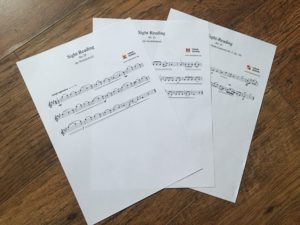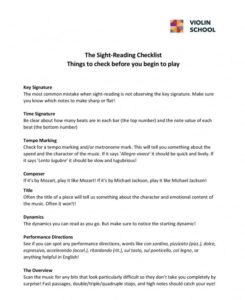 Sight-reading is an important skill that you should be developing regularly during your usual violin practice sessions. A good approach is to try at least one new piece of music every day (or every time you practise). If you have lots of time to practise (e.g. 2 or more hours per day), then of course you can do more than that!
Sight-reading is an important skill that you should be developing regularly during your usual violin practice sessions. A good approach is to try at least one new piece of music every day (or every time you practise). If you have lots of time to practise (e.g. 2 or more hours per day), then of course you can do more than that!
Sight-reading practice doesn't have to take long. You can just choose a very short piece of music to read. Try to get into the habit of playing something new 'at sight' as often as you can. If you're a member of ViolinSchool, you can start with our library of sight-reading exercises - if you have time, try a new one every day!
When it comes to developing the skill of sight-reading, consistency and regularity of practice is far more important than length or difficulty. If you practise sight-reading simple pieces a lot, then your sight-reading skills will improve, and you'll find it much easier when you eventually try to sight-read longer and more difficult music.
But if you start trying to sight-read repertoire that's too advanced for you, you will struggle to develop your skills correctly, and you may become demotivated. So be sure that you're not trying to tackle pieces that are too hard.
So you're in your practice room and you've chosen the piece or exercise that you want to use to develop your sight-reading skills.
But what do you do next?
Here's a useful method we've developed that will help you stay focused in your practice:
1) TRY IT!
 Glance over the whole piece that you're about to play, and make sure you consider everything on 'The Sight-Reading Checklist', so that you're clear about exactly what you need to do.
Glance over the whole piece that you're about to play, and make sure you consider everything on 'The Sight-Reading Checklist', so that you're clear about exactly what you need to do.
Then, try playing it through once - straight through from beginning to end. Don't stop, don't go back, just perform it as best you can.
2) PRACTISE IT!
Now it's time for a second look. Play through the piece again, but do it slowly, carefully, and fastidiously... this time, you can stop and practise any bits that need practising.
3) METRONOME IT!
Play it through again - this time with a metronome! One of THE most important things to consider when you're sight-reading something is the timing - particularly the pulse of the music and the rhythm of the notes.
Don't worry about making mistakes - it's usually much more important for the music to STAY IN TIME than it is to get every note 100% right.
This is especially the case if you are playing with other people; even if the notes aren't totally accurate it's still possible to keep playing together, but if one person gets the timings wrong then the whole piece will fall apart!
4) PERFORM IT!
Imagine you are giving a concert, and try to give the best performance you possibly can - make it confident, convincing, accurate, and musical. Remember, you're now practising performing as well as sight-reading... so whatever you do, don't stop! You can always go back and fix any mistakes afterwards.
**
Remember this list to help keep your sight-reading practice efficient and effective!
**
Always remember that sight-reading is a learnable skill, so the more you do it, the better you'll become. Sight-reading is a critical skill for succeeding in a group environment, so you'll also rapidly build up your confidence - which is especially useful if you're playing with other people.
By making time for sight-reading on a regular basis and ensuring that you are always practising in a clear, ordered way, you will also be improving your overall musicianship and performance skills, as well as your violin technique.
One of the most crucial decisions to the performance and interpretation of any piece of music is the speed. Getting the speed right allows room for all the intricate levels of technique and expression to work; it creates the mood, tells the story and allows the music to dance.
When we play in an orchestra, the conductor indicates the speed of the piece with his upbeat and subsequent arm movements. In smaller ensembles, the speed of a piece must be decided between the musicians, and somebody has to lead. This is helped by everybody breathing together as the upbeat is given. In violin practice, we can use a metronome or our own sense of pulse, and choose a practice speed that allows us to work effectively.

The speed of a piece of music is called the tempo, which is just the Italian word for time. In fact, most of the words we need to learn in order to understand the speed and feel of the music we play are Italian. In the 17th century, when tempo indications were first used extensively, defined and standardised, many of the important composers were Italian, and these terms have remained widely used in music to the present day.
There tends to be no tempo indication in music written before this method came into common use. In Baroque music, conventions governing composition were so strong that the speed of the music is hardly ever indicated. When Bach wrote a Giga, it was understood what speed that Giga, or jig, was meant to go.
In Renaissance music, most pieces were understood to flow at a speed roughly the same as the human heart rate. The note value which corresponded to this pulse, known as the tactus, was defined by the time signature, so 3/4, 2/2 and 6/4 would indicate different speeds as much as a different musical emphasis.
Many musical forms, particularly those derived from dances, have their own tempo too, so no instruction is given in the music. When we see a waltz, minuet or tango, we understand the speed and mood from our knowledge of the dance, period and style.
The tempo of a piece of music is sometimes indicated by a metronome marking which is measured in beats per minute (BPM). The note value that gives the beat is specified by the time signature. For example in 4/4, the beat is a crotchet. The speed is dictated by the amount of time between beats, specified as a fraction of a minute. A metronome marking of crotchet = 60 means there is one crotchet beat per second, and a metronome marking of crotchet = 120 means there are two crotchet beats per second; so crotchet = 120 is twice as fast as crotchet = 60.

The metronome was invented by Johann Maelzel in 1816. Music written before the metronome became popular will only have metronome markings if they are editorial. One of the first composers to include these mathematical tempo indications himself was Beethoven, but his markings create more questions than answers; they are inconsistent or sometimes impractical, leading to the theory that his metronome didn’t work very well! The modern digital metronomes are much more reliable.
Despite appearing very specific, metronome markings are nearly always only an approximate guide. Depending on the time signature, your musical interpretation and even the acoustic where you are performing, the markings may not always be appropriate.

Most pieces of music are given Italian words as tempo indications. These words are much more specific in their descriptions of how a piece should go than a metronome mark, as they often give an indication not only of speed, but of the character and mood of the music. For example, whilst Presto means fast and Allegro also means fast, the Italian meaning of the word Allegro is joyous or gleeful, giving a new intention to the music.
Tempo markings are also frequently accompanied by descriptive words which give a deeper indication of how the music should sound.
The understanding and interpretation of tempo markings must be affected by when the music was written. Tempos have changed over the course of time, and some of the terms have switched places. A modern Largo is slower than an Adagio, but in Baroque music it was faster.
Let’s have a look at some of the most common words you will see:
Grave – slow and solemn
Lento – slow
Largo – slow and broad
Larghetto – quite slow and broad
Adagio – slow and stately, meaning “at ease” in Italian
Andante moderato – a bit slower than Andante
Andante – at a walking pace
Moderato – at a moderate tempo
Allegretto – moderately fast
Allegro – fast, quickly and bright
Vivace – lively and fast, from the Latin, vīvāx, literally meaning full of life
Presto – extremely fast (168–177 BPM)
As with dynamics, basic tempo markings can be adjusted in various ways:
Tempo can often fluctuate through a movement to give musical interest. Tempo changes are often written into the music, and there are specific terms for these too.
Composers often use expressive marks to adjust the tempo in the middle of a piece. Elgar is famous for his exacting instructions and some of his works have a different tempo marking every few bars!

Here’s what they all mean:
The overall tempo indication will always appear in large type above the stave, whereas tempo adjustments such as accelerandos or ritenutos generally appear below the stave.
After a change of speed, a composer may indicate the return to a previous tempo by marking a tempo or tempo primo. These terms indicate an immediate return to the main tempo of the piece.
Alongside the instructions which exist purely to give an idea of the speed, composers use a huge variety of descriptive words. The slow movement of Elgar’s String Quartet is given a metronome marking alongside which it is simply marked piacevole, which means peacefully. Given the context of Elgar’s music, this word conjures up bucolic interpretations of this peace and gives a clear idea of his intention for the mood. It would mean something different from another composer.
The number of words used to give the character sometimes precludes understanding without the aid of an Italian dictionary, but many of them are quite similar to English words. Here are a few examples of descriptions that often accompany tempo markings:
Although Italian is the most common language for tempo and expression markings, many composers write in their own language. Debussy, Ravel and Rameau wrote their instructions in French, and Beethoven, Mahler and Strauss used German.
Take time to learn as many tempo words as you can, and notice which other words regularly appear at the top of your music. Listen to the music you are learning, and to other music by the same composer or from the same period of musical history. Watch dancers performing modern and ancient dances and listen to folk music.
Tempo markings give a clear academic definition to the speed of a piece, but only practice, immersion in listening and experience will really help you to choose the speed which makes the music work best for you and your audience.
